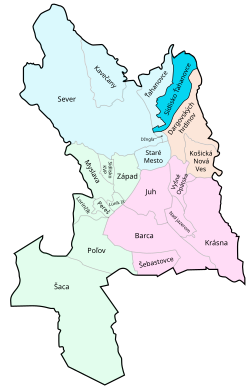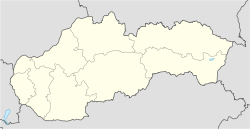Top Qs
Timeline
Chat
Perspective
Sídlisko Ťahanovce
Borough in Slovakia From Wikipedia, the free encyclopedia
Remove ads
Sídlisko Ťahanovce ([pronunciation: 'seedlisko 'tyahano-utse], literally: "Ťahanovce Housing Estate", Hungarian: Tihany-lakótelep) is a borough (city ward) of Košice, Slovakia. Constructed in the late 1980s and consisting almost exclusively of prefabs, the estate offers little in terms of work opportunities or recreation, causing residents to spend most of their daytime elsewhere.[5] The estate has long suffered from traffic jams and petty crime. The number of residents has slowly declined as more affluent inhabitants moved out but as of 2024 remains above 20,000, making the Ťahanovce Housing Estate one of most densely populated parts of Košice.
Remove ads
Remove ads
History
Summarize
Perspective
Construction of the housing estate started on 18 May 1984 nearby the village of Ťahanovce, which was an independent village until 1969 when it became incorporated in the city of Košice. Originally, the intention was to demolish the village and expand the housing estate over its location but the plan was later abandoned and the village was left standing. As a result, there are now two similarly named districts - Ťahanovce (the old village) and Sídlisko Ťahanovce (the housing estate) located next to each other. After initial landscaping works were done, the construction of prefabs started in May 1985. The first inhabitants moved in June 1988. The estate became an independent district within the city of Košice in 1990.[6]
Renaissance tower
Almost all buildings in the estate are communist-era prefabs and so there are few architecturally notable construction. The only exception is a renaissance style tower from mid 17th century, originally constructed to mark an important trade route crossroad. The tower fell into disrepair in the 20th century but was renovated in 2002 to mark the occasion of visit of the president of Poland Aleksander Kwaśniewski to Košice. The tower is of historical importance to Poland as Polish volunteers who died in the area while covering retreat of Hungarian forces in the Hungarian Revolution of 1848 were buried there. The tower is prominently displayed on the coat of arms of the estate.[7]
Demeter
An informal settlement, with a varying population of between 80 and 500 Romani people called Demeter grew around three small apartment buildings built in the late 1980s to house the Romani people.[8] The informal housing was demolished in 2011 with the residents forcefully moved to other locations, while the original appartment buildings retained to serve as social housing.[9]
Remove ads
Transportation
The estate is connected to the other parts of the city only by road. In mid 2010s, there was a plan to connect the estate with a tram line, which would also connect the estate to the train station located in the Ťahanovce village, but the project was indefinitely delayed.[10]
Demographics
As of 2023, Sídlisko Ťahanovce has about 20,000 inhabitants. This number represents a decline from the peak of 23,700 inhabitants 2006, caused by emigration. Historically, the population of the housing estate was very young because the newly constructed apartments were assigned predominantly to young families. As of 2004, children under 14 represented nearly a fourth of the estate inhabitants, while only 1.7% of residents were senior citizens above 65 years of age. In 2023, the share of children declined to under 13% and the share of senior citizens grew to 10%.[1]
According to the 2021 census, the average of the residents of the estate age is 39 years. About 30% of inhabitants have a collage degree. In terms of religion 52% belongs to the Catholic Church (45% Roman is Catholic, the rest Greek Catholic), about 5% belongs to Protestant denominations and 2% are Orthodox Christian. About 30% of residents do not belong to any religious denomination. 88% of residents are Slovaks.[11]
Safety
Due to the youthful population, Sídlisko Ťahanovce and lack of public spaces, the estate struggled with the relatively high rate of petty crime and drug use in the 2000s.[12] Nonetheless, according to an analysis of crime in Košice produced by the municipal police in 2014, the rate of crime in the estate was about equal to city average.[13]
Religion
A separate Latin rite Catholic parish for the housing estate was established in July 1995 by the decision of the Archbishop of Roman Catholic Archdiocese of Košice Alojz Tkáč. At the time, masses were held in a small chapel build from prefabs in February 1995. The construction of a church started in 2024. The newly constructed parish church dedicated to Saint Dominic Savio was consecrated in May 2022 by the Archbishop Bernard Bober. The old chapel was demolished in Fall 2022. The parish serves about 9,500 faitful living in the estate.[14][15]
The Slovak Greek Catholic Church with about 1,500 faithful in the estate was originally served by the parish priest from the neighboring Furča housing estate. In 2001, a separate parish in Ťahanovce estate was created and a small chapel dedicated to Saints Pavel Peter Gojdič and Dominik Trčka was constructed.[16]
Remove ads
Notable people
- Richard Tury (born 1993) - professional skateboarder
Gallery
- Apartment blocks from a distance
- Apartment blocks at Sídlisko Ťahanovce
- A fountain at Sídlisko Ťahanovce
- Elementary school at Bruselská Street is the biggest one in the whole Slovakia
- Overall panorama of Ťahanovce and Sídlisko Ťahanovce
References
External links
Wikiwand - on
Seamless Wikipedia browsing. On steroids.
Remove ads









